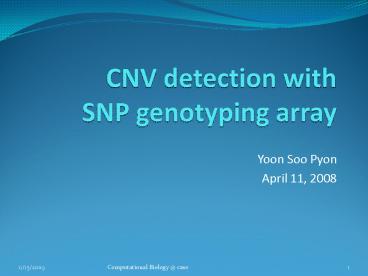CNV detection with SNP genotyping array - PowerPoint PPT Presentation
1 / 20
Title:
CNV detection with SNP genotyping array
Description:
dChipSNP (Lin et al., Bioinformatics 2004) CNAT (Bignell et al., Genome Research 2004) ... CARAT (Huang et al., BMC Bioinformatics 2006) PennCNV (Wang et al. ... – PowerPoint PPT presentation
Number of Views:736
Avg rating:3.0/5.0
Title: CNV detection with SNP genotyping array
1
CNV detection with SNP genotyping array
- Yoon Soo Pyon
- April 11, 2008
2
What is CNV and LOH
Homozygous deletion Copy number 0
Hemizygous deletion Copy number 1
Normal Copy number 2
Copy neutral LOH Copy number 2
amplication Copy number 6
3
Two methods of CNV identification
- Clone-based comparative genomic hybridization
(Array CGH) - Test and reference DNA are differentially
fluorescent labeled and hybridized to the array. - cons low resolution (Cannot find small CNV
region) - SNP genotyping array
- pros Higher resolution
- Cons poor signal-to-noise ratio of hybridization
4
Generation of SNP genotyping array
- Ilummina Bead Array
- Human-1 Beadchip (100,000)
- 240,000 BeadArray
- 300,000
- 550,000
- 650,000
- 1 Million just released. (human1M)
- Affymetrix SNP array
- 10,000 (Mapping 10K array, 2003)
- 100,000 (Mapping 100K array)
- 500,000 (Mapping 500K array)
- 1 Million just released (Genome-wide Human SNP
6.0)
5
(No Transcript)
6
SNP probe
- Target (250-2000 bp)
- CAGACAGAAGTCTTGA/CAATCTATTTCTCATA...
- PMA TGTCTTCAGAACTTTAGATAAAGAG
- MMA TGTCTTCAGAACATTAGATAAAGAG
- PMB TGTCTTCAGAACGTTAGATAAAGAG
- MMB TGTCTTCAGAACCTTAGATAAAGAG
- PMA o TCTTCAGAACTTTAGATAAAGAGTA
- MMA o TCTTCAGAACTTAAGATAAAGAGTA
- PMB o TCTTCAGAACGTTAGATAAAGAGTA
- MMB o TCTTCAGAACGTAAGATAAAGAGTA
7
SNP probe, CNV probe (Affymetrix)
- Mapping 100K
- 1 probe set 40 probes (20 PM, 20 MM), 25 bp/each
- SNP6.0
- 906,600 SNP probes, 946,000 CNV probes
- 1 SNP probe set 68 probes (all PM), 25 bp/each
- CNV probe (1 probe/probe set) 202,000 probes
targeting 5,677 known regions of copy number
variation, 3,182 distinct, nonoverlapping
segments, each interrogated with an average of 61
probes. In addition, more than 744,000 probes
were chosen evenly spaced along the genome to
find novel CNVs.
8
SNP Genotyping
- Fluorescent intensity signal of A/B allele
A
B
A
B
A
B
B
A
SNP genotyping
normalized Intensity value
Intensity signal
CNV detection and inference
9
SNP genotyping
10
Copy number and LOH detecting algorithms using
SNP array data
- dChipSNP (Lin et al., Bioinformatics 2004)
- CNAT (Bignell et al., Genome Research 2004)
- GIM (Ishikawa et al., Bioc. Biophys. Res. Comm.
2005) - CNAG (Nannya et al., Cancer Research 2005)
- PLASQ (LaFramboise et al., PLoS Comp. Bio. 2005,
Biostatistics 2007) - CARAT (Huang et al., BMC Bioinformatics 2006)
- PennCNV (Wang et al., Genome Research 2007)
- QuantiSNP (Colella et al., Nucleic Acids Research
2007)
11
PLASQ
- Generalized linear model based CNV detection
algorithm
12
PennCNV
- Hidden Markov Model designed for high resolution
CNV detection in whole genome SNP genotyping data
13
PennCNV (contd.)
- Log R ratio (LRR) total fluorescent intensity
signals from both sets of probe/allele at each
SNP - B Allelle Frequence (BAF) relative ratio of the
intensity signals between two probes/allele at
each SNP - Accurate model for log R ratio and B Allele
Frequency - Population allele frequency distance between
adjacent SNPs family information
14
PennCNV (contd.)
15
PennCNV inference of LRR and BAF
(X,Y)
- X, Y normalized signal intensity
- R XY total signal intensity
- T arctan(Y/X)/(p/2)
TBB
TAB
T
TAA
16
PennCNV (contd.)
- First order HMM assumes that the hidden copy
number state at each SNP depends only the copy
number state of the most preceding SNP. - ri, bi, zi log R ratio, B allele Frequency,
Copy number state at SNP i (1 I ltM)
17
PennCNV, emission probability
- Emission probability of log R ratio
- Emission probability of B allele Frequency
18
PennCNV Transition probability of hidden states
- Probability of having a copy number state change
between two adjacent SNPs. - Intuition The copy number state is unlikely to
change for SNPs that are nearby but is more
likely to change for SNPs that are far apart. - D is constant number. 100MB for state4 and 100KB
for others - Value p are treated as unknown parameter and
estimated in the Baum-Welch algorithm
19
PennCNV parameter estimation and CNV calling
- Baum-Welch algorithm for training model to
maximize the likelihood of the observed data of
each individual - Viterbi algorithm to infer most likely path.
- CNV is called most likely state sequence whenever
a stretch of states that is different from normal
state is observed.
20
Thank you































